Related Research Articles
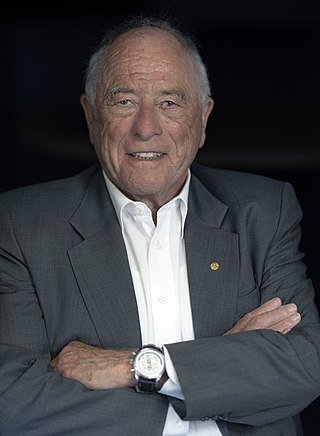
Kurt Wüthrich is a Swiss chemist/biophysicist and Nobel Chemistry laureate, known for developing nuclear magnetic resonance (NMR) methods for studying biological macromolecules.
Louis Siminovitch was a Canadian molecular biologist. He was a pioneer in human genetics, researcher into the genetic basis of muscular dystrophy and cystic fibrosis, and helped establish Ontario programs exploring genetic roots of cancer.

Anthony James Pawson was a British-born Canadian genetic scientist.
Tak Wah Mak, is a Canadian medical researcher, geneticist, oncologist, and biochemist. He first became widely known for his discovery of the T-cell receptor in 1983 and pioneering work in the genetics of immunology. In 1995, Mak published a landmark paper on the discovery of the function of the immune checkpoint protein CTLA-4, thus opening the path for immunotherapy/checkpoint inhibitors as a means of cancer treatment. Mak is also the founder of Agios Pharmaceuticals, whose lead compound, IDHIFA®, was approved by the FDA for acute myeloid leukemia in August 2017, becoming the first drug specifically targeting cancer metabolism to be used for cancer treatment. He has worked in a variety of areas including biochemistry, immunology, and cancer genetics.

Oliver Smithies was a British-American geneticist and physical biochemist. He is known for introducing starch as a medium for gel electrophoresis in 1955, and for the discovery, simultaneously with Mario Capecchi and Martin Evans, of the technique of homologous recombination of transgenic DNA with genomic DNA, a much more reliable method of altering animal genomes than previously used, and the technique behind gene targeting and knockout mice. He received the Nobel Prize in Physiology or Medicine in 2007 for his genetics work.
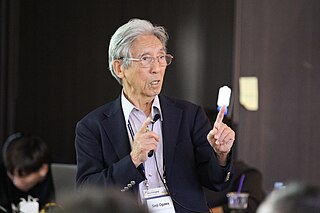
Seiji Ogawa is a Japanese biophysicist and neuroscientist known for discovering the technique that underlies Functional Magnetic Resonance Imaging (fMRI). He is regarded as the father of modern functional brain imaging. He determined that the changes in blood oxygen levels cause its magnetic resonance imaging properties to change, allowing a map of blood, and hence, functional, activity in the brain to be created. This map reflected which neurons of the brain responded with electrochemical signals to mental processes. He was the first scientist who demonstrated that the functional brain imaging is dependent on the oxygenation status of the blood, the BOLD effect. The technique was therefore called blood oxygenation level-dependent or BOLD contrast. Functional MRI (fMRI) has been used to map the visual, auditory, and sensory regions and moving toward higher brain functions such as cognitive functions in the brain.
Adriaan "Ad" Bax is a Dutch-American molecular biophysicist. He was born in the Netherlands and is the Chief of the Section on Biophysical NMR Spectroscopy at the National Institutes of Health. He is known for his work on the methodology of biomolecular NMR spectroscopy. He is a corresponding member of the Royal Netherlands Academy of Arts and Sciences, a member of the National Academy of Sciences, a fellow of the American Academy of Arts and Sciences, and a Foreign Member of the Royal Society.

Joan Elaine Argetsinger Steitz is Sterling Professor of Molecular Biophysics and Biochemistry at Yale University and Investigator at the Howard Hughes Medical Institute. She is known for her discoveries involving RNA, including ground-breaking insights into how ribosomes interact with messenger RNA by complementary base pairing and that introns are spliced by small nuclear ribonucleic proteins (snRNPs), which occur in eukaryotes. In September 2018, Steitz won the Lasker-Koshland Award for Special Achievement in Medical Science. The Lasker award is often referred to as the 'American Nobel' because 87 of the former recipients have gone on to win Nobel prizes.

Mildred Cohn was an American biochemist who furthered understanding of biochemical processes through her study of chemical reactions within animal cells. She was a pioneer in the use of nuclear magnetic resonance for studying enzyme reactions, particularly reactions of adenosine triphosphate (ATP).
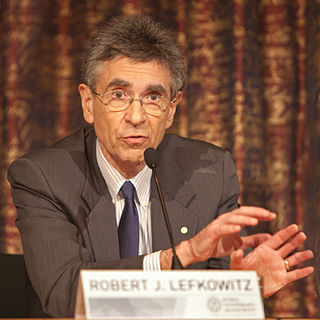
Robert Joseph Lefkowitz is an American physician and biochemist. He is best known for his discoveries that reveal the inner workings of an important family of G protein-coupled receptors, for which he was awarded the 2012 Nobel Prize for Chemistry with Brian Kobilka. He is currently an Investigator with the Howard Hughes Medical Institute as well as a James B. Duke Professor of Medicine and Professor of Biochemistry and Chemistry at Duke University.
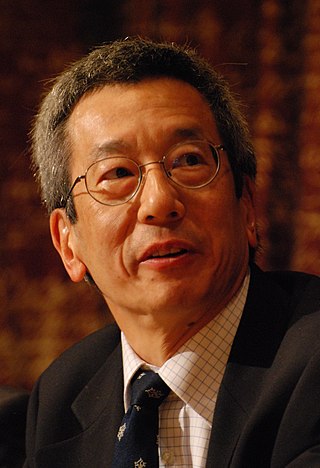
Roger Yonchien Tsien was an American biochemist. He was a professor of chemistry and biochemistry at the University of California, San Diego and was awarded the Nobel Prize in Chemistry in 2008 for his discovery and development of the green fluorescent protein, in collaboration with organic chemist Osamu Shimomura and neurobiologist Martin Chalfie. Tsien was also a pioneer of calcium imaging.
Franz-Ulrich Hartl is a German biochemist and the current Executive Director of the Max Planck Institute of Biochemistry. He is known for his pioneering work in chaperone-mediated protein folding.
Nahum Sonenberg, is an Israeli Canadian microbiologist and biochemist. He is a James McGill professor of biochemistry at McGill University in Montreal, Quebec, Canada. He was an HHMI international research scholar from 1997 to 2011 and is now a senior international research scholar. He is best known for his seminal contributions to our understanding of translation, and notable for the discovery of the mRNA 5' cap-binding protein, eIF4E, the rate-limiting component of the eukaryotic translation apparatus.
Reginald John Ellis is a British scientist.

Sir Christopher Martin Dobson was a British chemist, who was the John Humphrey Plummer Professor of Chemical and Structural Biology in the Department of Chemistry at the University of Cambridge, and Master of St John's College, Cambridge.
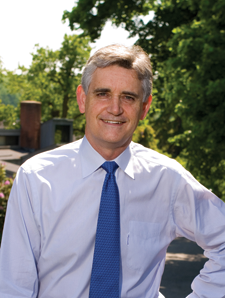
Bruce William Stillman is a biochemist and cancer researcher who has served as the Director of Cold Spring Harbor Laboratory (CSHL) since 1994 and President since 2003. He also served as the Director of its NCI-designated Cancer Center for 25 years from 1992 to 2016. During his leadership, CSHL has been ranked as the No. 1 institution in molecular biology and genetics research by Thomson Reuters. Stillman's research focuses on how chromosomes are duplicated in human cells and in yeast Saccharomyces cerevisiae; the mechanisms that ensure accurate inheritance of genetic material from one generation to the next; and how missteps in this process lead to cancer. For his accomplishments, Stillman has received numerous awards, including the Alfred P. Sloan, Jr. Prize in 2004 and the 2010 Louisa Gross Horwitz Prize, both of which he shared with Thomas J. Kelly of Memorial Sloan-Kettering Cancer Center, as well as the 2019 Canada Gairdner International Award for biomedical research, which he shared with John Diffley.

Joachim Heinrich Seelig was a German physical chemist and specialist in NMR Spectroscopy. He was one of the founding fathers of the Biozentrum of the University of Basel. He reached emeritus status in 2012.

Gerhard Wagner is a German-American physicist. Currently the Elkan Rogers Blout Professor of Biological Chemistry and Molecular Pharmacology at Harvard Medical School, he is an Elected Fellow of the American Association for the Advancement of Science, German National Academy of Sciences Leopoldina, American Academy of Arts and Sciences, National Academy of Sciences and International Society of Magnetic Resonance.
R. Mark Henkelman was a Canadian biophysics researcher in the field of medical imaging, who was appointed as a Fellow of the Royal Society of Canada (2005) and the Order of Canada (2019) in recognition of his pioneering contributions to the field of magnetic resonance imaging. He passed away June 28, 2024.
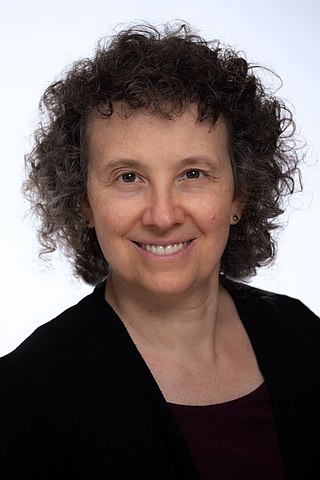
Julie Forman-Kay is a scientist at the Hospital for Sick Children (SickKids) and professor at University of Toronto. Her research focuses on the dynamics, interactions, structures, and functions of intrinsically disordered proteins.
References
- ↑ "2017 Canada Gairdner Laureates Announced!". March 28, 2017.
- 1 2 3 4 5 6 7 8 9 10 11 12 "Lewis E. Kay".
- ↑ "2020 NAS Election". www.nasonline.org.
- ↑ General, Office of the Secretary to the Governor. "The Governor General of Canada". The Governor General of Canada.
- ↑ "U of T's Lewis E. Kay named Canada Gairdner International Award Laureate". University of Toronto.
- ↑ "2019 Honorary Degree Recipients | Okanagan Graduation". graduation.ok.ubc.ca.
- ↑ "SBGrid Consortium - Member Tale - Julie Forman-Kay - The Hospital for Sick Children, University of Toronto". sbgrid.org. Retrieved May 8, 2021.